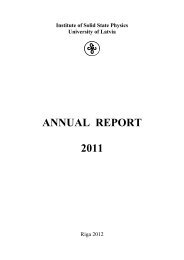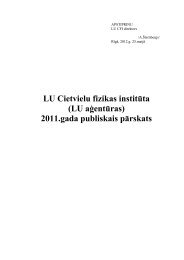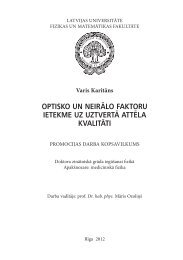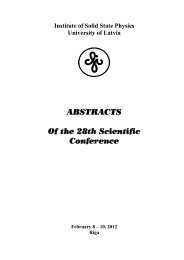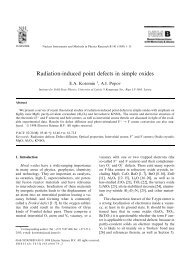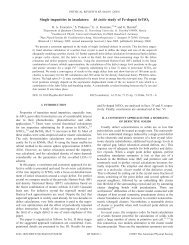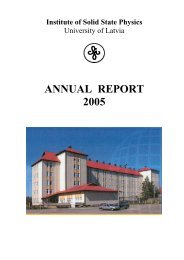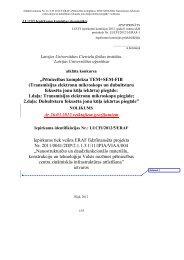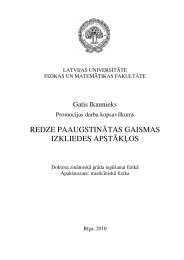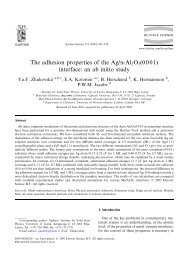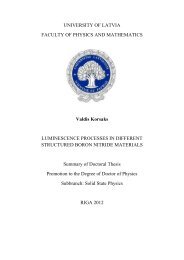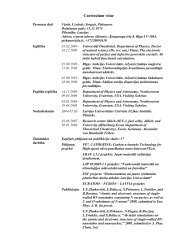Annual Report 2012 - Latvijas Universitātes Cietvielu fizikas institūts
Annual Report 2012 - Latvijas Universitātes Cietvielu fizikas institūts
Annual Report 2012 - Latvijas Universitātes Cietvielu fizikas institūts
You also want an ePaper? Increase the reach of your titles
YUMPU automatically turns print PDFs into web optimized ePapers that Google loves.
enables sensitive and selective detection of interstitial O 2 . Advantages of this method<br />
and results of evaluation of oxygen exchange between interstitial O 2 and the a-SiO 2<br />
network are presented.<br />
OXYGEN-EXCESS-RELATED POINT DEFECTS IN GLASSY/AMORPHOUS<br />
SiO 2 AND RELATED MATERIALS<br />
L. Skuja, (a) K. Kajihara, (b) M. Hirano, (c) and H. Hosono (c,d)<br />
(a)<br />
Institute of Solid State Physics, URiga, Latvia<br />
(b)<br />
Department of Applied Chemistry, Graduate School of Urban Environmental<br />
Sciences, Tokyo Metropolitan University, 1-1 Minami-Osawa,<br />
Hachioji 192-0397, Japan<br />
(c)<br />
Frontier Collaborative Research Center, Mail Box S2-13, Tokyo Institute of<br />
Technology, 4259 Nagatsuta, Midori-ku, Yokohama 226-8503, Japan<br />
(d)<br />
Materials and Structures Laboratory, Tokyo Institute of Technology, 4259 Nagatsuta,<br />
Midori-ku, Yokohama 226-8503, Japan<br />
An insight is given into recent experimental advances in the spectroscopic studies of<br />
oxygen-excess intrinsic defects, in glassy SiO 2 and α-quartz. By controlling excess<br />
oxygen in a-SiO 2 , and the conditions of F 2 -laser irradiation, SiO 2 glass samples can be<br />
obtained with optical absorption almost exclusively dominated by single defect, oxygen<br />
dangling bonds ("non-bridging oxygen hole centers" or NBOHCs), without the presence<br />
of complementary Si dangling bonds (generic “E’-centers”). This allows for a more<br />
accurate determination of the spectral shape of NBOHC optical absorption in UV and<br />
vacuum UV spectral regions. The temperature dependence of NBOHC electron<br />
paramagnetic resonance (EPR) signal intensity is stronger than predicted by Curie’s law<br />
(1/T) even at temperatures at and below 77K. Dangling bonds are characteristic of an<br />
amorphous state and do not exist in a regular crystal lattice. However, site-selective<br />
luminescence shows that highly ordered NBOHCs exist in particle-irradiated α-quartz,<br />
evidently either on the border between the damage tracks and the crystalline phase or as<br />
a part of Si vacancies. They are different from the common “glass-like” NBOHCs in a-<br />
SiO 2 by giving distinct sharp zero-phonon lines with characteristic energies in<br />
luminescence spectra instead of a continuous distribution of lines. Two distinct types of<br />
luminescent NBOHCs, associated with the long and short Si-O bonds in α-quartz are<br />
suggested. EPR data corroborate the presence of oriented NBOHCs in neutron-irradiated<br />
α-quartz and confirm distinct NBOHCs at the sites of “long” and “short” Si-O bonds in<br />
α-quartz.<br />
Scientific publications<br />
1. L. Skuja, K. Kajihara, M. Hirano, H. Hosono, Oxygen-excess-related point defects in<br />
glassy/amorphous SiO 2 and related materials Nuclear Instruments and Methods in<br />
Physics Research Section B. v.286, p.159-168 (<strong>2012</strong>) .<br />
2. K.Kajihara, L.Skuja, H. Hosono, 18 O-labeled interstitial oxygen molecules as probes<br />
to study reactions involving oxygen-related species in amorphous SiO 2 , J. Non-<br />
Crystalline Solids vol. 358 3524–3530 (<strong>2012</strong>).<br />
3. I Mihailovs, J Kreicberga, V Kampars, S Miasojedovas, S Juršenas, L Skuja and M<br />
Rutkis, Hyper-Rayleigh scattering and two-photon luminescence of phenylamineindandione<br />
chromophores, IOP Conf. Series: Materials Science and Engineering, vol.<br />
38 p.012035 (<strong>2012</strong>) .<br />
97



